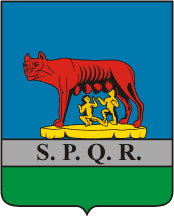Wyświetl większą mapę
Rzym to największe miasto Włoch (2.750.000 mieszkańców), stolica kraju i siedziba rządu. Wieczne miasto na 7 wzgórzach. I znowu - trzeba było podzielić mój Rzym na kilka części, ponieważ materiału jest dość sporo - wiadomo, co Rzym, to Rzym. Zaczniemy od krótkiego spaceru ulicą della Concilliazione, która prowadzi z Watykanu do Zamku Św. Michała.
Rome is Italy's largest city (2,750,000 inhabitants), the country's capital and seat of government. The eternal city on 7 hills. And again - I had to divide my Rome into a few parts because there is quite a lot of material - you know what Rome is Rome. We'll start walking down the street della Concilliazione that leads from the Vatican to the Castle of St.. Michael.
Via di Porta Angelica
Brama Anielska - Porta Angelica
Angel Gate
Kościół Santa Maria di Traspontina z 1566
Santa Maria di Traspontina church from 1566
Widok w kierunku placu św. Piotra
A wiev towards St. Peter Square
Zamek Św. Michała
Dzisiejszy zamek był pierwotnie monumentalnym grobowcem cesarza Hadriana i jego rodziny. Wzniesiono go z rozkazu cesarza w latach 123-139 r. n.e. Prochy władcy spoczywały tu do XII w., kiedy to panujący ówcześnie papież postanowił przeznaczyć budowlę dla siebie. Później sarkofag Hadriana spłonął w pożarze. W średniowieczu zmieniono grobowiec w fortecę, która przez około tysiąc lat pozostawała najpotężniejszym punktem obronnym Rzymu. W dobie renesansu, w dolnej części budowli mieściły się więzienia, a w górnej luksusowe apartamenty papieskie oraz archiwum i skarbiec Państwa Kościelnego (do dziś można tam oglądać potężny kufer-sejf). Papież Juliusz II, który lubił przebywać na zamku, zlecił urządzenie w górnej części budynku specjalnej loży błogosławieństw wychodzącej w kierunku rzeki i mostu. (za naszrzym.pl)
St. Michael's castle
The castle was originally a monumental tomb of Emperor Hadrian and his family. It was built on the orders of the emperor in the years 123-139 AD Here lay the ashes of the rulers of the XII c., when the reigning pope has decided to allocate building for themselves. Later, Hadrian's sarcophagus was burned in the fire. In the Middle Ages they changed a tomb in a fortress, which remained the most powerful point defense of Rome for about one thousand years. During the Renaissance, in the lower part of the building there was the jail in the top luxury suites and the papal archives and the treasury of the Papal States (to this day you can see there a mighty trunk-safe). Pope Julius II, who liked to stay in the castle, ordered the unit on top of the building a special box in the direction of the Beatitudes overlooking the river and the bridge.
Most św. Michała
St. Michael's bridge
Tybr
Tiber River
Skrzyżowanie via Paola z Lungotevere degli Altoviti, już po drugiej stronie mostu
Crossing of via Paola with Lungotevere degli Altoviti on the other bank of the river









































Brak komentarzy:
Prześlij komentarz